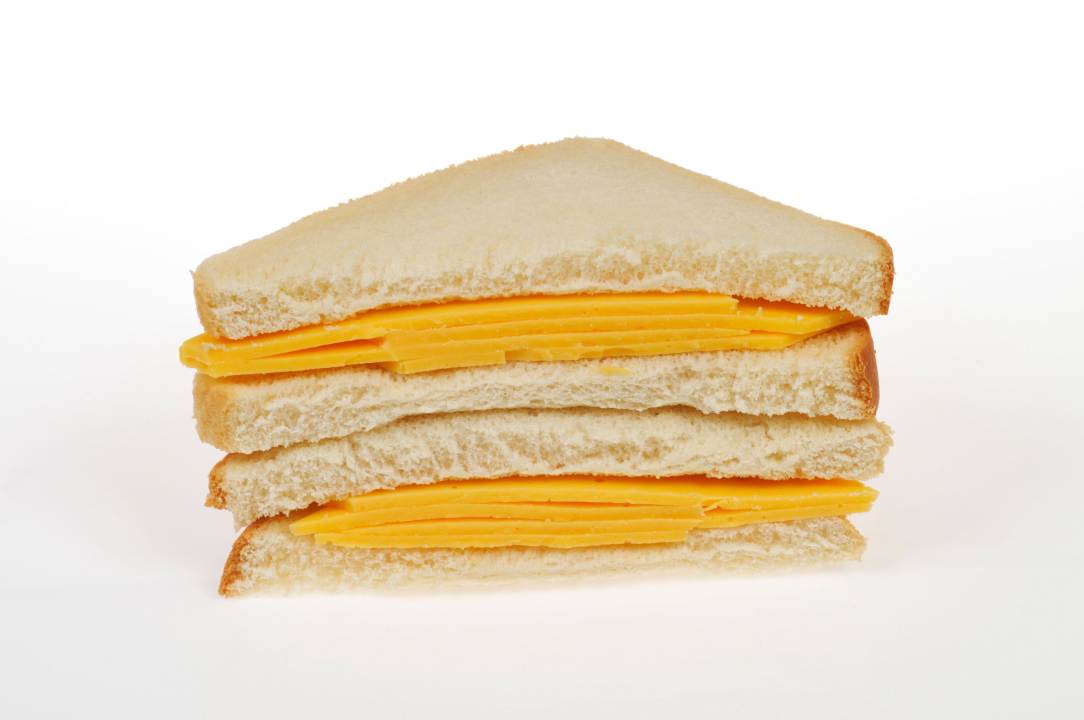Sad things, cheese sandwiches, especially in their most basic form. Most would add a garnish: pickle, tomato and onion are the most popular. Cowards. The point of a cheese sandwich is its beigeness. This is fuel, not food. Consoling sad corporate workers at their desks. Rows upon rows of sandwiches on Tesco shelves: ‘Cheese – no mayonnaise.’ No mayonnaise is important. That would be too much fun.
Everyone knows how the Earl of Sandwich repurposed bread and beef and started an eating revolution. No one really knows who first put cheese into the mix, however. The first mention seems to be from William Shakespeare’s The Merry Wives of Windsor, where Nym refers to a dish of ‘bread and cheese’. It’s hard to tell whether he meant a sandwich, of course. But something feels right about imagining legions of doughy Englishmen chomping on cheese sandwiches for centuries: aboard the Golden Hinde, beside the entrance to the coal mine, sheltering from bombs. Did the Duke of Wellington have one in his pocket at Waterloo? Did Churchill speak like that because his cheeks were stuffed with cheddar? Bread and cheese were in the post-war rationing packs. Is that proof?
It is exceedingly important that a cheese sandwich doesn’t taste too nice. That would be against the spirit of a ‘staple’ food. Anyway, indulgence at lunchtime is a continental thing, and it’s utility for us. The cheese sandwich is Stakhanovite because it can be eaten so quickly, with hands.
Did the Duke of Wellington have one in his pocket at Waterloo? Did Churchill speak like that because his cheeks were stuffed with cheddar?
Caprese ciabattas – laden with basil, mozzarella and tomato – are lovely. They are not a cheese sandwich. Because really, this is a cheddar sandwich we’re talking about. Red Leicester, perhaps. But anything else, and you’re struggling. A halloumi sandwich wouldn’t work – bit squeaky. Brie is too soft for mushy factory bread. A Parmesan sandwich would break your teeth.
Cheddar, though, is perfect. How can it not be everyone’s favourite cheese? There must be a reason that dogs – unconstrained by convention, or health anxiety, or guilt – seem to prefer cheddar to everything else. Mine can smell it being taken out of the fridge in nanoseconds. If I get home merry, I often give him a decent slab straight from the packet. Then give myself one.
I made a cheese sandwich for the first time in a while this week, after Ann Widdecombe told me not to. Widdecombe was asked by a journalist what she would say to people who can’t afford the ingredients of one during the cost-of-living crisis. ‘Well then you don’t do the cheese sandwich,’ she replied. Uproar followed. But she had a point: if you’re looking for a food hit by inflation, you can’t do much worse than a cheese sandwich.
The price of making one at home has jumped by more than a third over the past year. It’s because dairy farming is energy intensive: the cheesemaker Assosia reports that its red Leicester has gone up 25 per cent in price. The price of butter too has soared. I was once told – and this was before the current crisis – that there are two great shocks to adulthood: the ubiquity of cocaine and the price of cheese. If inflation doesn’t slow down, could the latter become more expensive? Soon there’ll be county lines gangs funnelling baggies of cheddar out to those in withdrawal.
It’s reassuring to see the near-spiritual panic Widdecombe prompted, though. You can’t tell a Brit we can’t have a cheese sandwich, even though, if we’re honest, we don’t really want one. It’s a sad thing, and that’s the point.







Comments